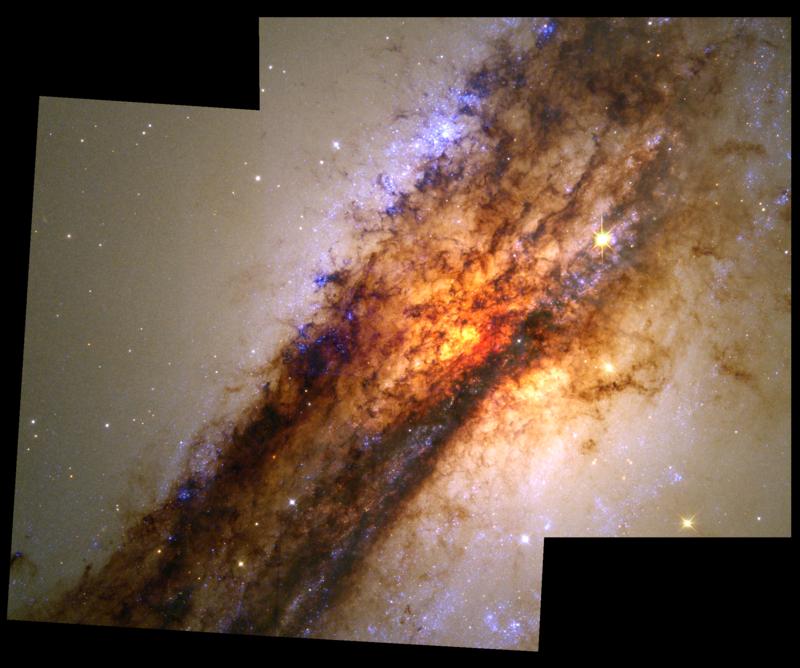







| BOOKS | F. A. Q. | ARTICLES | TALKS | ABOUT KEN | DONATE | BEYOND OUR KEN |
|---|
By Ken Croswell
May 31, 2006

Centaurus A: not your typical elliptical. Image by the Hubble Space Telescope. Ethan J. Schreier (Space Telescope Science Institute) and NASA.
For the first time, astronomers have detected Cepheids in an elliptical galaxy--Centaurus A--and used them to measure its distance. The astronomers, based in Canada and the United States, say the galaxy is about 11 million light-years from Earth.
Cepheids are the gold standard among extragalactic distance indicators. They are pulsating yellow supergiant stars that brighten and fade as they expand and contract. Just as a larger musical instrument resonates at a lower pitch, so a bigger and brighter Cepheid pulsates more slowly. Thus, by measuring a Cepheid's pulsation period, astronomers can deduce the Cepheid's intrinsic brightness; comparing this with the star's apparent brightness yields the distance to the Cepheid--and to its host galaxy.
But Cepheids are young stars, so they don't exist in galaxies having only old stars. Unfortunately, old stars abound in elliptical galaxies, the very galaxies that mark the centers of many galaxy clusters, including the nearby Virgo cluster. Virgo's distance would be better known if its central galaxies had Cepheids.
Now Laura Ferrarese and Peter Stetson of the Herzberg Institute of Astrophysics in Victoria, British Columbia; Jeremy Mould of the National Optical Astronomy Observatory in Tucson, Arizona; John Tonry of the University of Hawaii in Honolulu; John Blakeslee of Washington State University in Pullman; and Edward Ajhar of St. Thomas University in Miami Gardens, Florida, have used the Hubble Space Telescope to observe one of the nearest giant elliptical galaxies, Centaurus A.
 Centaurus A is not a typical elliptical. It is the nearest
radio galaxy to Earth, emitting copious radio waves, a hallmark
of a disturbance. Centaurus A seems to have had an encounter
with another galaxy, which sprayed gas and dust across its
bulge. This collision triggered the birth of young
stars--including, say Ferrarese and her colleagues, quite a few
Cepheids.
Centaurus A is not a typical elliptical. It is the nearest
radio galaxy to Earth, emitting copious radio waves, a hallmark
of a disturbance. Centaurus A seems to have had an encounter
with another galaxy, which sprayed gas and dust across its
bulge. This collision triggered the birth of young
stars--including, say Ferrarese and her colleagues, quite a few
Cepheids.
By measuring the brightnesses and periods of 42 Cepheids, Ferrarese and her colleagues find that Centaurus A is 11.2 � 0.6 (random) � 0.8 (systematic) million light-years from Earth. In the past, astronomers have measured the galaxy's distance by observing its red giants, planetary nebulae, Miras (pulsating red giants), and fluctuations in the surface brightness of its bulge. These methods have yielded a slightly larger distance to Centaurus A, ranging from 11.5 to 12.7 million light-years.
"It's probably one of the more challenging applications of Cepheids that I've seen," says Barry Madore, a Cepheid expert at the Carnegie Observatories in Pasadena, California. "The amount of reddening is just horrendous, because it's a very dusty galaxy." The dust absorbs and reddens the Cepheids' light. Nevertheless, says Madore, "It looks like they have a fairly robust answer."
But not even the Hubble Space Telescope can find Cepheids in the giant elliptical galaxies at the Virgo cluster's core. "The only reason that there are Cepheids in Centaurus A is because it's had an episode of star formation, because of this merger event," says Madore. "The ellipticals in Virgo are pretty much devoid of any current star formation." Thus, they don't have Cepheids.
However, in the future, Ferrarese and her colleagues plan to measure the Cepheid distance to NGC 4647, a spiral galaxy that's interacting with M60, a giant elliptical in Virgo. They hope the distance to the first galaxy reveals the distance to the second--and thereby to the center of the Virgo cluster.
Ferrarese and her colleagues will publish their work about Centaurus A in The Astrophysical Journal.
Ken Croswell is an astronomer and the author of Magnificent Universe and a book about cosmology, The Universe at Midnight.
Magnificent Universe by Ken Croswell is elegant and eloquent."--Kathy Sawyer, Washington Post. See all reviews of Magnificent Universe here.
"The Universe at Midnight is vastly entertaining and enjoyable, as well as informative."--Sir Patrick Moore, New Scientist. See all reviews of The Universe at Midnight here.
| BOOKS | F. A. Q. | ARTICLES | TALKS | ABOUT KEN | DONATE | BEYOND OUR KEN |
|---|